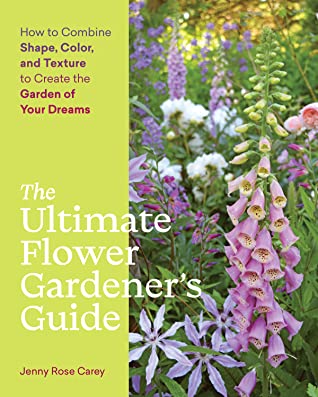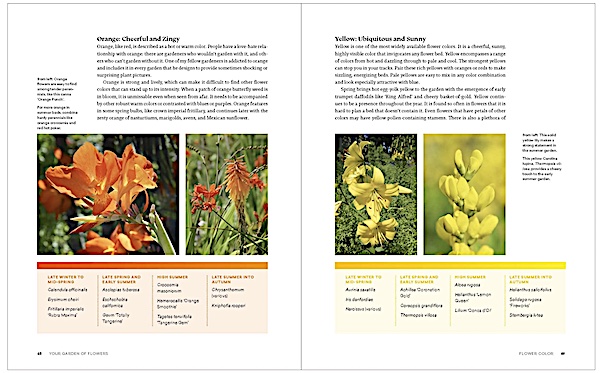Making Your Good Flower Garden Even Better
by George Graine, emeritus, Fairfax Master Gardener
“In his own garden every man may be his own artist without apology or explanation.” — Louise Beebe Wilder in Colour in My Garden (1918)
 You will be pleased to read Jenny Rose Carey’s practical and easy to comprehend book, “The Ultimate Flower Gardener’s Guide: How to Combine Shape, Color, and Texture to Create the Garden of Your Dreams” (Timber Press, 2022). Why? Because in this book she also discusses planting schemes that provide insight, ideas, inspiration and confidence for your dream flower garden.
You will be pleased to read Jenny Rose Carey’s practical and easy to comprehend book, “The Ultimate Flower Gardener’s Guide: How to Combine Shape, Color, and Texture to Create the Garden of Your Dreams” (Timber Press, 2022). Why? Because in this book she also discusses planting schemes that provide insight, ideas, inspiration and confidence for your dream flower garden.
There are many flower choices to select from at full service garden centers, a lesser amount at box stores and still fewer at seasonal pop-up locations. Perhaps confusion sets in on the dilemma of what to buy and where to put new plants into your flower garden. Often the problem seems to be how to select plants that will meet your own expectations. Do not become confused or overwhelmed before venturing out to any of these places. Ask yourself several important questions such as: Where do you intend to garden on your own property? Is it in sun or shade or both? Have you considered nourishing pollinators? What about native as well as non-native plants? By the way, did you have your soil tested in order to see if it is compatible with new flower purchases? These are just a few questions to consider so that you do not become overwhelmed at some local flower mart. In clear explanations, Carey explains how a unique flower garden can become your own pride and joy and even one you would like to share with others.
From the book “Epilogue — Into the Future,” Carey writes “A flower garden is never static. Your garden will change week by week, season by season, and year by year as buds open to reveal new and beautiful floral combinations. This evolution is central to the enjoyment of flower gardening.” What does this really mean? Help is on the way when Carey goes on to say that “ . . . a flower garden requires a combination of learned knowledge, practical experience, and some creative flair.” Clearly, Carey shows you how to achieve positive results for your flower garden in the five chapters of her book. One day the plant du jour will be waiting for you; if not now, then soon. Consider her book as an opportunity to solve problems as well as to also make some flower garden changes that heretofore you had not given much thought to. This means to go beyond flower color as well as consideration of flower shape, texture, height, width and other meaningful concerns. All of these choices should come together so that they are aesthetically pleasing to the eye. In addition, keep in mind that while a flower garden can be beautiful, do not ignore the bones of the garden including trees and shrubs and of course those little bitty groundcover plants and more. All of these plants tend to enhance each other, and they should not be neglected in your overall landscape design.
New flower types continue to grow at a fast pace. This is because the green industry keeps hybridizing plants and crossing one flower with another until hopefully they reach a sellable product such as the yet to be produced plant du jour. Often these new flower products are found online and later at full service garden centers. They will usually take a bit longer before they show up in the box stores. Flower diversity, leading to sales, is obviously the name of the game, and gardeners have an opportunity to be on the receiving end of this phenomenon. Sometimes these plants are in limited supply so be prepared to pay a higher price than the tried and true old standbys.
Carey’s 360+ page book is really a godsend because she helps sort out so much flower garden information into a single book. Using a building block approach, the book includes five chapters that will help you accomplish your flower garden goals.
 In Chapter 1 “Your Garden of Flowers,” you will learn how to combine and consider flowers in terms of their shape, role in the garden, presence and of course, color. Chapter 2 is concerned with “The Flower Gardener’s Calendar.” Now you will find a guide to necessary chores (tasks and activities) in the garden. All of these efforts are necessary in order to keep your flower garden functioning and attractive, regardless of the season. These are not one and done activities because plants need your help especially during the growing season. For example, and depending on the plant, they may need staking, deadheading, cutting back and more. Both of these chapters will enhance Chapter 3 “The Flower Gardener’s Palette.”
In Chapter 1 “Your Garden of Flowers,” you will learn how to combine and consider flowers in terms of their shape, role in the garden, presence and of course, color. Chapter 2 is concerned with “The Flower Gardener’s Calendar.” Now you will find a guide to necessary chores (tasks and activities) in the garden. All of these efforts are necessary in order to keep your flower garden functioning and attractive, regardless of the season. These are not one and done activities because plants need your help especially during the growing season. For example, and depending on the plant, they may need staking, deadheading, cutting back and more. Both of these chapters will enhance Chapter 3 “The Flower Gardener’s Palette.”
This third chapter makes up about 40 percent of the book, and more than 200 genera of plants are included. At first glance this may appear to be overwhelming; however, each flower appears in alphabetical order. To some this may be a good or maybe not such a good approach. Nevertheless, a 13-page index, in small type, is helpful for a quick lookup. Each flower is shown in a full color photo including much more plant information than usually is found on a typical garden nursery pot plant tag. Some of the advice indicates how a flower can best be used in a garden setting by bloom time, size and more. This information will help you to reach a garden design that enhances your own flower garden ideas. Coincidentally, give some thought to what you are trying to accomplish before rushing into choosing plants for your garden. Whereas some of the early chapters are akin to a support system, they do provide some rationale for the why and how of the flower garden.
Now that you have read about the flower part of your garden, you still need to determine the importance of a garden location on your own property. In Chapter 4 you will learn about “Laying the Groundwork for Your Flower Garden.” Here you will find how to consider the ideal location for the new garden. As noted earlier, think about the sun-shade paradigm. At the same time, consider how you can become inspired as you go about the process of designing your flower garden. The last chapter is “Putting Your Flower Garden Together.” This chapter puts just about everything into perspective. It is important because it provides you with more practical advice on preparing, planning, planting and maintaining the garden.
In summary, “The Ultimate Flower Gardener’s Guide” will provide you with a fresh perspective on the how and why of the importance of how shape, color and ease of flower cultivation can become your own special place on your quarter acre of the planet. At this late date, perhaps it is time to consider your own 2023 enhanced flower garden. It is not too early to start.